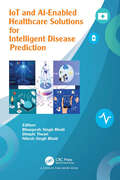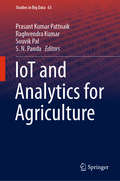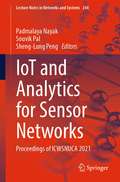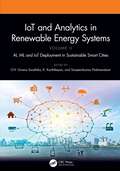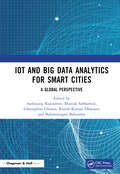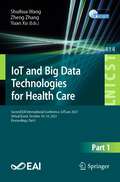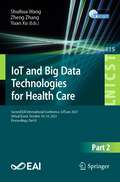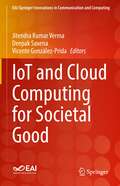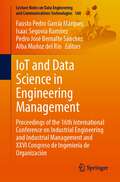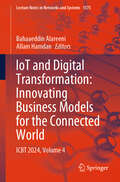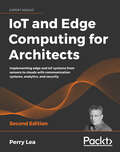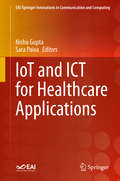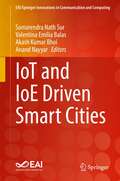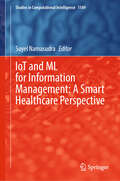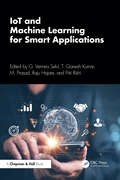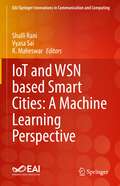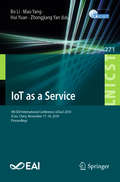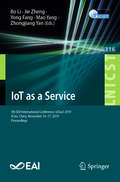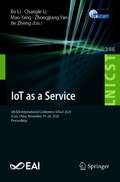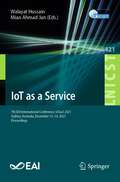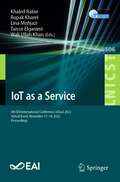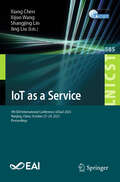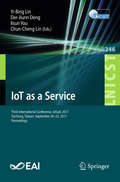- Table View
- List View
IoT and AI-Enabled Healthcare Solutions and Intelligent Disease Prediction
by Bhoopesh Singh Bhati Dimple Tiwari Nitesh Singh BhatiThe book presents fundamental to advanced concepts of AI and IoT in healthcare and disease prediction, demonstrating the emerging mechanisms, including machine learning, deep learning, image sensing, and explainable AI models to handle issues in healthcare industries with real-life scenarios. Included chapters are contributed by experienced professionals and academicians who examine severe diseases, applications, models, tools, frameworks, case studies, applications, and best practices in Healthcare. This book integrates the medical domain with AI technology. It covers trending explainable AI, computer vision (CV), and IoT that facilitate automation for healthcare solutions and medical diagnostics. The primary focus on explainable AI uncovers the black box of deep learning and bridges the distance between medical professionals and technologists. IoT in Healthcare: provides a mechanism of image sensing and is helpful in surgical tools.
IoT and Analytics for Agriculture (Studies in Big Data #63)
by Prasant Kumar Pattnaik Raghvendra Kumar Souvik Pal S. N. PandaThis book presents recent findings on virtually every aspect of wireless IoT and analytics for agriculture. It discusses IoT-based monitoring systems for analyzing the crop environment, and methods for improving the efficiency of decision-making based on the analysis of harvest statistics. In turn, it addresses the latest innovations, trends, and concerns, as well as practical challenges encountered and solutions adopted in the fields of IoT and analytics for agriculture. In closing, it explores a range of applications, including: intelligent field monitoring, intelligent data processing and sensor technologies, predictive analysis systems, crop monitoring, and weather data-enabled analysis in IoT agro-systems.
IoT and Analytics for Sensor Networks: Proceedings of ICWSNUCA 2021 (Lecture Notes in Networks and Systems #244)
by Sheng-Lung Peng Souvik Pal Padmalaya NayakThis book includes high-quality research papers presented at the 1st International Conference on Wireless Sensor Networks, Ubiquitous Computing and Applications (ICWSNUCA, 2021), which is held at Gokaraju Rangaraju Institute of Engineering and Technology, Hyderabad, India, during 26–27 February, 2021. This volume focuses on the applications, use-cases, architectures, deployments, and recent advances of wireless sensor networks as well as ubiquious computing. Different research topics are illustrated in this book, like wireless sensor networks for the Internet of Things; IoT applications for eHealth; smart cities; architectures for WSNs and IoT, WSNs hardware and new devices; low-power wireless technologies; wireless ad hoc sensor networks; routing and data transfer in WSNs; multicast communication in WSNs; security management in WSNs and in IoT systems; and power consumption optimization in WSNs.
IoT and Analytics in Renewable Energy Systems (Volume 1): Sustainable Smart Grids & Renewable Energy Systems
by O. V. Gnana SwathikaSmart grid technologies include sensing and measurement technologies, advanced components aided with communications and control methods along with improved interfaces and decision support systems. Smart grid techniques support the extensive inclusion of clean renewable generation in power systems. Smart grid use also promotes energy saving in power systems. Cyber security objectives for the smart grid are availability, integrity and confidentiality. Five salient features of this book are as follows: AI and IoT in improving resilience of smart energy infrastructure IoT, smart grids and renewable energy: an economic approach AI and ML towards sustainable solar energy Electrical vehicles and smart grid Intelligent condition monitoring for solar and wind energy systems
IoT and Analytics in Renewable Energy Systems (Volume 2): AI, ML and IoT Deployment in Sustainable Smart Cities
by Sanjeevikumar Padmanaban K. Karthikeyan O. V. Gnana SwathikaSmart cities emanate from a smart renewable-energy-aided power grid. The smart grid technologies offer an array of benefits like reliability, availability, and resiliency. Smart grids phenomenally contribute to facilitating cities reaching those sustainability goals over time. Digital technologies, such as the Internet of Things (IoT), automation, artificial intelligence (AI) and machine learning (ML) significantly contribute to the two-way communication between utilities and customers in smart cities. Five salient features of this book are as follows: Smart grid to the smart customer Intelligent computing for smart grid applications Novel designs of IoT systems such as smart healthcare, smart transportation, smart home, smart agriculture, smart manufacturing, smart grid, smart education, smart government, smart traffic management systems Innovations in using IoT and AI in improving resilience of smart energy infrastructure Challenges and future research directions of smart city applications
IoT and Big Data Analytics for Smart Cities: A Global Perspective
by Balamurugan Balusamy Gheorghita Ghinea Rajesh Kumar Dhanaraj Sathiyaraj Rajendran Munish SabharwalThe book IoT and Big Data Analytics (IoT-BDA) for Smart Cities – A Global Perspective, emphasizes the challenges, architectural models, and intelligent frameworks with smart decisionmaking systems using Big Data and IoT with case studies. The book illustrates the benefits of Big Data and IoT methods in framing smart systems for smart applications. The text is a coordinated amalgamation of research contributions and industrial applications in the field of smart cities. Features: • Provides the necessity of convergence of Big Data Analytics and IoT techniques in smart city application. • Challenges and Roles of IoT and Big Data in Smart City applications. • Provides Big Data-IoT intelligent smart systems in a global perspective. • Provides a predictive framework that can handle the traffic on abnormal days, such as weekends and festival holidays. • Gives various solutions and ideas for smart traffic development in smart cities. • Gives a brief idea of the available algorithms/techniques of Big Data and IoT and guides in developing a solution for smart city applications. This book is primarily aimed at IT professionals. Undergraduates, graduates, and researchers in the area of computer science and information technology will also find this book useful.
IoT and Big Data Technologies for Health Care: Second EAI International Conference, IoTCare 2021, Virtual Event, October 18-19, 2021, Proceedings, Part I (Lecture Notes of the Institute for Computer Sciences, Social Informatics and Telecommunications Engineering #414)
by Yuan Xu Zheng Zhang Shuihua WangThis two-volume set of LNICST 414 and 415 constitutes the refereed post-conference proceedings of the 2nd International Conference on IoT and Big Data Technologies for Health Care, IoTCARE 2021, which took place in October 2021. Due to COVID-19 pandemic the conference was held virtually. The 79 revised full papers were carefully reviewed and selected from 165 submissions. The papers are arranged thematically as follows: Integrating healthcare with IoT; Information fusion for the devices of IoT; AI-based internet of medical things.
IoT and Big Data Technologies for Health Care: Second EAI International Conference, IoTCare 2021, Virtual Event, October 18-19, 2021, Proceedings, Part II (Lecture Notes of the Institute for Computer Sciences, Social Informatics and Telecommunications Engineering #415)
by Yuan Xu Zheng Zhang Shuihua WangThis two-volume set of LNICST 414 and 415 constitutes the refereed post-conference proceedings of the 2nd International Conference on IoT and Big Data Technologies for Health Care, IoTCARE 2021, which took place in October 2021. Due to COVID-19 pandemic the conference was held virtually. The 79 revised full papers were carefully reviewed and selected from 165 submissions. The papers are arranged thematically as follows: Integrating healthcare with IoT; Information fusion for the devices of IoT; AI-based internet of medical things.
IoT and Cloud Computing for Societal Good (EAI/Springer Innovations in Communication and Computing)
by Jitendra Kumar Verma Deepak Saxena Vicente González–Prida DíazThis book gathers the state-of-the-art for industrial application of scientific and practical research in the Cloud and IoT paradigms to benefit society. The book first aims to discuss and outline various aspects of tackling climate change. The authors then discuss how Cloud and IoT can help for digital health and learning from industrial aspects. The next part of book discusses technical improvements in the fields of security and privacy. The book also covers Smart Homes and IoT in agriculture. The book is targeted towards advancing undergraduate, graduate, and post graduate students, researchers, academicians, policymakers, various government officials, NGOs, and industry research professionals who are currently working in the field of science and technology either directly or indirectly to benefit common masses.
IoT and Data Science in Engineering Management: Proceedings of the 16th International Conference on Industrial Engineering and Industrial Management and XXVI Congreso de Ingeniería de Organización (Lecture Notes on Data Engineering and Communications Technologies #160)
by Fausto Pedro García Márquez Isaac Segovia Ramírez Pedro José Bernalte Sánchez Alba Muñoz del RíoThis book presents the selected research works from the 16th International Conference on Industrial Engineering and Industrial Management in 2022. The conference was promoted by ADINGOR (Asociación para el Desarrollo de la Ingeniería de Organización), organized by Ingenium Research Group at Universidad de Castilla-La Mancha, Spain, and it took place on July 7th and 8th, 2022, in Toledo, Spain. The book highlights some of the latest research advances and cutting-edge analyses of real-world case studies on Industrial Engineering and Industrial Management from a wide range of international contexts. It also identifies business applications and the latest findings and innovations in Operations Management and in Decision Sciences.
IoT and Digital Transformation: ICBT 2024, Volume 4 (Lecture Notes in Networks and Systems #1575)
by Allam Hamdan Bahaaeddin AlareeniThis book examines how smart devices, sensors, and interconnected data ecosystems are redefining business operations, enhancing customer experiences, and shaping new competitive strategies. In today&’s hyperconnected world, the Internet of Things (IoT) is more than a technology trend, it is a transformative force driving digital innovation across industries. Offering a comprehensive exploration of IoT&’s role in business transformation, this book illustrates how traditional models are evolving into agile, data-driven systems. Through diverse research methodologies and real-world case studies, it addresses the key opportunities and challenges presented by connected environments. It serves as a practical guide for business leaders, innovators, and policymakers aiming to harness IoT&’s full potential for operational excellence and sustainable growth. What You&’ll Discover: · How IoT is enabling new forms of business model innovation · Strategies for integrating IoT into digital transformation initiatives · Policy and managerial insights for connected industries <span lang="DE" style="font-family: Symbol; mso-fareast-font-family: Symbol; mso-bid
IoT and Edge Computing for Architects: Implementing edge and IoT systems from sensors to clouds with communication systems, analytics, and security, 2nd Edition
by Perry LeaLearn to design, implement, and secure your IoT infrastructure. Revised and expanded for edge computing. Key Features Build a complete IoT system that's the best fit for your organization Learn about different concepts, tech, and trade-offs in the IoT architectural stack Understand the theory and implementation of each element that comprises IoT design Book Description Industries are embracing IoT technologies to improve operational expenses, product life, and people's well-being. An architectural guide is needed if you want to traverse the spectrum of technologies needed to build a successful IoT system, whether that's a single device or millions of IoT devices. IoT and Edge Computing for Architects, Second Edition encompasses the entire spectrum of IoT solutions, from IoT sensors to the cloud. It examines modern sensor systems, focusing on their power and functionality. It also looks at communication theory, paying close attention to near-range PAN, including the new Bluetooth® 5.0 specification and mesh networks. Then, the book explores IP-based communication in LAN and WAN, including 802.11ah, 5G LTE cellular, Sigfox, and LoRaWAN. It also explains edge computing, routing and gateways, and their role in fog computing, as well as the messaging protocols of MQTT 5.0 and CoAP. With the data now in internet form, you'll get an understanding of cloud and fog architectures, including the OpenFog standards. The book wraps up the analytics portion with the application of statistical analysis, complex event processing, and deep learning models. The book then concludes by providing a holistic view of IoT security, cryptography, and shell security in addition to software-defined perimeters and blockchains. What you will learn Understand the role and scope of architecting a successful IoT deployment Scan the landscape of IoT technologies, from sensors to the cloud and more See the trade-offs in choices of protocols and communications in IoT deployments Become familiar with the terminology needed to work in the IoT space Broaden your skills in the multiple engineering domains necessary for the IoT architect Implement best practices to ensure reliability, scalability, and security in your IoT infrastructure Who this book is for This book is for architects, system designers, technologists, and technology managers who want to understand the IoT ecosphere, technologies, and trade-offs, and develop a 50,000-foot view of IoT architecture. An understanding of the architectural side of IoT is necessary.
IoT and ICT for Healthcare Applications (EAI/Springer Innovations in Communication and Computing)
by Nishu Gupta Sara PaivaThis book provides an insight on the importance that Internet of Things (IoT) and Information and Communication Technology (ICT) solutions can have in taking care of people's health. Key features of this book present the recent and emerging developments in various specializations in curing health problems and finding their solutions by incorporating IoT and ICT. This book presents useful IoT and ICT applications and architectures that cater to their improved healthcare requirements. Topics include in-home healthcare services based on the Internet-of-Things; RFID technology for IoT based personal healthcare; Real-time reporting and monitoring; Interfacing devices to IoT; Smart medical services; Embedded gateway configuration (EGC); Health monitoring infrastructure; and more.Features a number of practical solutions and applications of IoT and ICT on healthcare;Includes application domains such as communication technology and electronic materials and devices;Applies to researchers, academics, students, and practitioners around the world.
IoT and IoE Driven Smart Cities (EAI/Springer Innovations in Communication and Computing)
by Valentina Emilia Balas Akash Kumar Bhoi Anand Nayyar Samarendra Nath SurThis book provides detail on applying Internet of Things (IoT) and Internet of Everything (IoE) in smart cities and their design aspects related to physical and network layer models. The authors explore the possibilities of utilizing communication technologies like multi-input multi-output (MIMO), narrow-band IoT (NB-IoT), ultra-reliable low latency communications (URLLC), enhanced mobile broadband (eMBB), and massive machine-type communications (mMTC) for successful implementation of the IoT/IoE. The authors also address the development and advancement in cloud computing to support IoT and IoE. Research on the challenges and future predictions for efficiently implementing and exploring the benefits of smart cities are also explored. The book pertains to researchers, academics, and professionals in the field.Discusses the applicability of Internet of Things (IoT) and Internet of Everything (IoE) for smart cities;Addresses different protocols, networks, and technologies related to the implementation of IoT and IoE for smart cities;Provides a detailed overview on the physical and network layer design and signal processing algorithms related to IoT and IoE.
IoT and ML for Information Management: A Smart Healthcare Perspective (Studies in Computational Intelligence #1169)
by Suyel NamasudraThis book discusses the roles of the Internet of Things (IoT) and machine learning (ML) in smart health care, including the integration of cloud computing with IoT and ML for managing healthcare data. It presents the fundamentals and many applications of IoT and ML in different areas of smart health care. It deliberates upon security and privacy issues, including trust concerns about smart healthcare systems based on IoT and ML algorithms. This book is concluded by discussing challenges and future work directions in smart health care using IoT and ML, and it serves as a reference resource for researchers and practitioners in academia and industry.
IoT and Machine Learning for Smart Applications
by T. Ganesh Kumar G. Vennira Selvi M. Prasad Raju Hajare Priti RishiThis book provides an illustration of the various methods and structures that are utilized in machine learning to make use of data that is generated by IoT devices. Numerous industries utilize machine learning, specifically machine learning-as-a-service (MLaaS), to realize IoT to its full potential. On the application of machine learning to smart IoT applications, it becomes easier to observe, methodically analyze, and process a large amount of data to be used in various fields.Features: Explains the current methods and algorithms used in machine learning and IoT knowledge discovery for smart applications Covers machine- learning approaches that address the difficulties posed by IoT- generated data for smart applications Describes how various methods are used to extract higher- level information from IoT- generated data Presents the latest technologies and research findings on IoT for smart applications Focuses on how machine learning algorithms are used in various real- world smart applications and engineering problems It is a ready reference for researchers and practitioners in the field of information technology who are interested in the IoT and Machine Learning fields.
IoT and OT Security Handbook: Assess risks, manage vulnerabilities, and monitor threats with Microsoft Defender for IoT
by Smita Jain Vasantha Lakshmi Dr Rohini SrivathsaLeverage Defender for IoT for understanding common attacks and achieving zero trust for IoT and OT devicesPurchase of the print or Kindle book includes a free PDF eBookKey FeaturesIdentify and resolve cybersecurity challenges in the IoT and OT worldsFamiliarize yourself with common attack vectors in the IoT and OT domainsDive into Defender for IoT, understand its capabilities, and put it to practiceBook DescriptionThe Fourth Industrial Revolution, or Industry 4.0, is all about digital transformation, manufacturing, and production. The connected world we live in today, including industries, comes with several cybersecurity challenges that need immediate attention. This book takes you through the basics of IoT and OT architecture and helps you understand and mitigate these security challenges.The book begins with an overview of the challenges faced in managing and securing IoT and OT devices in Industry 4.0. You'll then get to grips with the Purdue model of reference architecture, which will help you explore common cyber attacks in IoT and OT environments. As you progress, you'll be introduced to Microsoft Defender for IoT and understand its capabilities in securing IoT and OT environments. Finally, you will discover best practices for achieving continuous monitoring and vulnerability management, as well as threat monitoring and hunting, and find out how to align your business model toward zero trust.By the end of this security book, you'll be equipped with the knowledge and skills to efficiently secure IoT and OT environments using Microsoft Defender for IoT.What you will learnDiscover security challenges faced in IoT and OT environmentsUnderstand the security issues in Industry 4.0Explore Microsoft Defender for IoT and learn how it aids in securing the IoT/OT industryFind out how to deploy Microsoft Defender for IoT along with its prerequisitesUnderstand the importance of continuous monitoringGet familiarized with vulnerability management in the IoT and OT worldsDive into risk assessment as well as threat monitoring and huntingAchieve zero trust for IoT devicesWho this book is forThis book is for industrial security, IoT security, and IT security professionals. Security engineers, including pentesters, security architects, and ethical hackers, who want to ensure the security of their organization's data when connected with the IoT will find this book useful.
IoT and WSN based Smart Cities: A Machine Learning Perspective (EAI/Springer Innovations in Communication and Computing)
by Shalli Rani R. Maheswar Vyasa SaiThis book provides an investigative approach to how machine learning is helping to maintain and secure smart cities, including principal uses such as smart monitoring, privacy, reliability, and public protection. The authors cover important areas and issues around implementation roadblocks, ideas, and opportunities in smart city development. The authors also include new algorithms, architectures and platforms that can accelerate the growth of smart city concepts and applications. Moreover, this book provides details on specific applications and case studies related to smart city infrastructures, big data management, and prediction techniques using machine learning.
IoT as a Service: 4th EAI International Conference, IoTaaS 2018, Xi’an, China, November 17–18, 2018, Proceedings (Lecture Notes of the Institute for Computer Sciences, Social Informatics and Telecommunications Engineering #271)
by Bo Li Mao Yang Hui Yuan Zhongjiang YanThis book constitutes the refereed post-conference proceedings of the Fourth International Conference on IoT as a Service, IoTaaS 2018, which took place in Xi’an, China, in November 2018. The 50 revised full papers were carefully reviewed and selected from 83 submissions. The technical track present IoT-based services in various applications. In addition, there are three workshops: international workshop on edge computing for 5G/IoT, international workshop on green communications for internet of things, and international workshop on space-based internet of things.
IoT as a Service: 5th EAI International Conference, IoTaaS 2019, Xi’an, China, November 16-17, 2019, Proceedings (Lecture Notes of the Institute for Computer Sciences, Social Informatics and Telecommunications Engineering #316)
by Yong Fang Bo Li Mao Yang Zhongjiang Yan Jie ZhengThis book constitutes the refereed post-conference proceedings of the Fifth International Conference on IoT as a Service, IoTaaS 2019, which took place in Xi’an, China, in November 2019. The 54 revised full papers were carefully reviewed and selected from 106 submissions. The papers contribute to the discussion on the challenges posed by Internet of Things (Io). The two technical tracks and three workshops deal in detail: Networking and Communications Technologies for IoT, IoT as a service, International Workshop on Edge Intelligence and Computing for IoT Communications and Applications, International Workshop on Wireless Automated Networking for Internet of Things, and International Workshop on Ubiquitous Services Transmission for Internet of Things.
IoT as a Service: 6th EAI International Conference, IoTaaS 2020, Xi’an, China, November 19–20, 2020, Proceedings (Lecture Notes of the Institute for Computer Sciences, Social Informatics and Telecommunications Engineering #346)
by Bo Li Mao Yang Zhongjiang Yan Jie Zheng Changle LiThis book constitutes the refereed post-conference proceedings of the 6st International Conference on IoT as a Service, IoTaaS 2020, which took place in Xi’an, China, in November 2020. Due to COVID-19 pandemic the conference was held virtually. The 69 revised full papers were carefully reviewed and selected from 136 submissions. The papers present two technical tracks and three workshops: The Second Workshop on Edge Intelligence and Computing for Iot Communications and Applications, the Workshop on Satellite Communication Networks for Internet of Things, the Workshop on Satellite Communications
IoT as a Service: 7th EAI International Conference, IoTaaS 2021, Sydney, Australia, December 13–14, 2021, Proceedings (Lecture Notes of the Institute for Computer Sciences, Social Informatics and Telecommunications Engineering #421)
by Mian Ahmad Jan Walayat HussainThis book constitutes the refereed post-conference proceedings of the 7th International Conference on IoT as a Service, IoTaaS 2021, which took place in Sydney, Australia, in December 2021. Due to COVID-19 pandemic the conference was held virtually. The 17 revised full papers were carefully reviewed and selected from 129 submissions. The papers are divided in content-related tracks: Intelligent IoT communication solutions; Social Internet of Things: security, management; Machine learning prediction and recommendation in IoT.
IoT as a Service: 8th EAI International Conference, IoTaaS 2022, Virtual Event, November 17-18, 2022, Proceedings (Lecture Notes of the Institute for Computer Sciences, Social Informatics and Telecommunications Engineering #506)
by Lina Mohjazi Khaled Rabie Rupak Kharel Taissir Elganimi Wali Ullah KhanThis book constitutes the refereed proceedings of the 8th EAI International Conference on IoT as a Service, IoTaaS 2022 was held virtually due to the COVID-19 crisis.The 17 full papers and 10 short papers included in this book were carefully reviewed and selected from 50 submissions. They were organized in topical sections as follows: Next generation wireless networks, Internet of Things, Artificial Intelligence, Wireless Communications, Vehicular Networks, Resource Optimization, Satellite communications and Machine Learning, Network Security.
IoT as a Service: 9th EAI International Conference, IoTaaS 2023, Nanjing, China, October 27-29, 2023, Proceedings (Lecture Notes of the Institute for Computer Sciences, Social Informatics and Telecommunications Engineering #585)
by Jing Liu Xiang Chen Xijun Wang Shangjing LinThis book constitutes the refereed post-conference proceedings of the 9th EAI International Conference on IoT as a Service, IoTaaS 2023. The conference took place in Nanjing, China, during October 27-29, 2023. The 33 revised full papers were carefully reviewed and selected from 85 submissions. The papers present state-of-the-art research work on the challenges and developments related to IoT systems.
IoT as a Service: Third International Conference, IoTaaS 2017, Taichung, Taiwan, September 20–22, 2017, Proceedings (Lecture Notes of the Institute for Computer Sciences, Social Informatics and Telecommunications Engineering #246)
by Ilsun You Der-Jiunn Deng Yi-Bing Lin Chun-Cheng LinThis book constitutes the thoroughly refereed proceedings of the 3rd International Conference on IoT as a service, IoTaaS 2017, held in Taichung, Taiwan, in September 2017. The 46 full papers were carefully selected from 65 submissions. The papers deal with the “Everything as a Service” deployment paradigm which enables the easy adoption of IoT based services and applications by end-users, and forces providers of smart objects and middleware platforms to architect their solutions accordingly. The three special sessions organized were Wearable Technology and Applications (WTAA), Building Smart Machine Applications (BSMA), and Security and Privacy in Internet of Things, Services and People (SP-IoTSP). The WTAA special session aimed to address the challenges of maintaining high efficiency of WTAA in terms of high recognition rate, energy consumption, computational costs and so forth. The BSMA special session aimed to explore how to construct smart machines architecture for the industry under the background of IoT and big data. The SP-IoTSP special session aimed to investigate recent research and future directions for IoTSP security and privacy.
